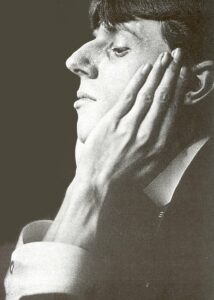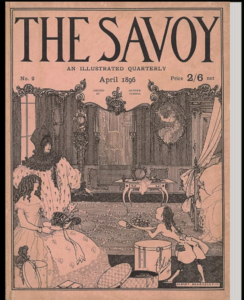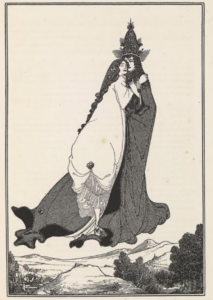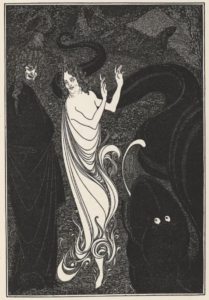Decadence and the Bourgeois: Aubrey Beardsley’s “Under the Hill”
© Copyright 2019 Kassandra Kurek, Ryerson University
Aubrey Beardsley andThe Savoy

Aubrey Vincent Beardsley (1872-1898) was a young author, editor and artist that worked on the fin-de-siècle magazine The Yellow Book, before moving to work as an art editor and contributor to The Savoy. Beardsley’s artwork is heavily featured in both magazines, and he has also contributed quite a few poems and short stories to The Savoy. Some notable pieces in his portfolio are “The Ballad of a Barber,” “Under the Hill,” and “The Ascension of Saint Rose of Lima.” In this exhibit, there will be focus on “Under the Hill,” “The Ascension of Saint Rose of Lima,” and the third tableau of “Das Rheingold,” the latter two being illustrations used as paratextual reference within his publication of “Under the Hill” in The Savoy. This publication will be the focus of my research in this exhibit, specifically the use of decadence within the

text. I plan to analyze how the hyper-focus on decedent objects within the text sends an anti-bourgeoisie message and speaks to greater Victorian society’s obsession with materialism. I will also use this focus on objects and the narrator’s enjoyment of them in order to speak to craft and consumption within the text, the objects being a beautiful craft and the consumption being the way they are enjoyed.
Beardsley was a very popular name in the artistic world of the 1890’s, but unfortunately only managed to live to the age of 26 after struggling with tuberculosis for most of his life. However, in his short life he accomplished many feats including establishing The Savoy along with Leonard Smithers, a long-time admirer of his who wanted to provide Beardsley with a new creative outlet for himself and other young artists (Nelson 60). After Beardsley’s unfortunate disposal from The Yellow Book due to an association to Oscar Wilde (Higgins 63), The Savoy became the main place he would publish his own work. It is Beardsley, along with Smithers, Arthur Symons, and other artists contributing their work that put together the very first edition of this magazine (Nelson 67). In later editions, Beardsley played a major role as a contributor and editor that followed as the magazine grew in popularity and began to compete with The Yellow Book and other major yellow nineties publications. Something that caused The Savoy to stand out among its competition was its slightly larger size, which allowed artwork to be seen more clearly and its high standards regarding what it would allow to be published within it. Targeted towards a middle class to upper middle-class audience, it experienced quite a bit of success during its publication and released eight volumes. The magazine itself is found to be bound together carefully, with slight ridges over the text and illustrations within and features a colourful cover while the illustrations and text within are black and white, something Beardsley was known for and excelled at (Gallatin 81).
The Decadence Movement
The fin-de-siècle brought along with itself many artistic and literary movements, including but not limited to: the arts and crafts movement, the aesthetic movement, the new women movement, the avant-garde movement, and a movement that is seen in “Under the Hill,” the decadence movement. The decadence movement is a literary movement that places heavy focus on extravagance, excess, and beauty within literature and life. It was one of many movements that Beardsley participated in but is the principle one exhibited in “Under the Hill,” as the setting is in a wealthy woman, Helen’s, home where Abbé Franfreluche, her guest and the narrator of the text, admires the many expensive, extravagant decorations and items within her home. Considering Beardsley is one of the more well-known decadent writers, it is not surprising that he wrote this text using inspiration from the movement. Although all works featuring decadence use common themes such as lavish descriptions of the setting of the text, authors writing in this movement would use it to make their own statements, utilizing their language to subtly allude to greater problems they saw in society and confront them. One of the more common allusions that would be made by decadent writers is one exposing the materialistic values of the wealthy, as the wealthy tended to be the greatest consumers of literature and art, as well as owners of beautiful, expensive items and homes that would be most commonly written about.
“Under the Hill,” A Decadent Story
When examining “Under the Hill” as a decadent story it is important to note the magazine it

was published in and who its target audience was. Published in the second volume of The Savoy, in April 1896, it was placed at the very end of the magazine as the final piece that readers would enjoy. Within the text, there are two illustrations used as paratexts as is mentioned above to contribute to text, meant to reflect the mental images Franfreluche creates as he observes the exquisite home, leading to detailed inner monologues filled with exquisite objects and clothing. The second sentence of the text, “The fresh wall-paper, the strange pictures, the positions of doors and windows, imperfectly grasped the night before, are revealed with all the charm of surprise when we open our eyes the next morning” (Beardsley 187) is the first example of decadence within the text. The instant focus on the home and the beauty within Helen’s guest bedroom reveals Beardsley’s inspiration from the decadence movement and sets the scene of the story. As the story continues, rich description of the bedroom and view from the window is used with each description being of a material object either within the bedroom or in the garden and each item being something expensive or extravagant. With descriptions of objects that are frilled, silken, or made of precious metals it is clear that he is placing importance on the items which symbolize wealth and beauty, staying true to the decadence movement. It is also the number of objects that Franfreluche focuses on that alludes to decadence within the text, as a major aspect of the decadence movement is excess of objects, excess of beauty, and excess of wealth and Beardsley has clearly aimed to show this.
As Franfreluche transitions between descriptions of all the beauty he is witnessing and his own thoughts, inspired by his surroundings, he still continues to use decadent language in his imagination. He does this by imagining pants he would have made for himself and the small details which would be included, describing what he imagines Saint Rose of Lima wore during her ascension, and the stage decorations from a play called “Bacchanals of Sporion.” Along with this descriptive language, Beardsley includes a drawing of Saint Rose on the next page, offering it as a paratext to allow the reader a visual perspective of what Franfreluche is imagining. In the illustration, both Mary and Saint Rose wear elaborate dresses, complete with delicate frills and flower detailing. Considering Saint Rose of Lima was a noble woman, a saint and not wealthy like the target audience of this text, it is clear that Beardsley simply transformed this story into something decadent to attract readers and suit the general theme of the text. He uses the fanciful in order to push this decadent narrative throughout the text, and it is very effective. In another paratext in the story, the third tableau from “Das Rheingold” there is a woman in all white, pictured on a black background wearing a delicate dress with many layers wrapping around her legs, putting more emphasis on the extravagance of the story. He even finishes off the text with another symbol of wealth; Helen feeding her unicorn, Adolphe.
Franfreluche and The Consumption of Objects
Peculiarly, one of the larger focuses of this text is not just excessive beauty and glamour but the excess of the objects themselves. Abbé Franfreluche spends the entirety of this text not only describing what he sees and imagines but fixates specifically on the objects themselves. While Franfreluche uses strong language to describe the very craft of what he is observing, he also brings the aspect of consumption into the text as the entire focus on the text is the objects themselves and the experience he is having as a result of his enjoyment. In fact, there is no true plot to the story as Franfreluche simply stays within the guest area of Helen’s home for the majority of the text. That’s what makes the consumption of objects the key theme in the text, as he focuses on little details in each thing he sees. From the curtains in the room to

the trousers he wanted to commission from a seamstress, he presents a heavy focus on details that although paint an image of what he sees and fabricates in his mind, do little to actually further the plot. One of the objects fixated on the most within the text is clothing and fabrics, something that can contribute to the idea that the people themselves are being viewed as extravagant based off of their clothing.
This is an idea scholars have studied before, and Forlini speaks to the fin-de-siècle presenting a new outlook on humanity itself, viewing humans as a sort of object meant to be fetishized (Forlini 494). This idea is one that applies to this text, as the descriptions surrounding Saint Rose of Lima, actors in “The Bacchanals of Sporion,” and Helen herself show the objectification and subsequent fetishization of the people themselves, as Beardsley ignores the people themselves and instead writes them like one would write a mannequin, modelling expensive delicate clothing and being a means to witnessing beauty. An example of this objectification for the sake of consumerism can be seen on page 191 of the magazine, when Franfreluche describes the actor playing Sporion in his mind leaving no description of the play, the performance, or the actors ability but instead spends many lines describing what he is wearing from head to toe. He describes the actor as wearing satin, muslin, stockings, and delicate footwear. In his description he sees the actor like one would observe a mannequin and provides many unnecessary details about what he is wearing and the colours of his clothing, mentioning little outside of the object of his desire (Beardsley 191). In this part of the text, although Franfreluche is describing a play, he spends his time describing the actors clothing instead of the play itself revealing the true decadent desire to consume the beauty around him and in his imagination. It also furthers Forlini’s belief that decadence included objectification of people themselves, seeing them as objects to be viewed.
A Message for the Bourgeoisie
It is clear that “Under the Hill” is a work of decadent fiction, however what appears in the text after a more careful examination is Beardsley’s own personal statement about what the true values of his readers are. By focusing the text on wealth, extravagant and therefore expensive items, he recognizes that his audience is mostly the upper-middle class in society. By recognizing who his audience is he specifically tailors his message to them, using their own desires for the very best and tastes for the fanciful in order to make a specific anti-bourgeoisie message that points out their true materialistic desires. His goal in making the text focus entirely on wealth and objects of wealth is to refer to what Snodgrass referred to as a sense of decadent delusions that the wealthy would often hold, and the way they rejected practicality in favour of excess (Snodgrass 60). Although Snodgrass was referring to more sexual aspects of Beardsley’s writing being used to allude to this, it can also be applied to his use of decadence as he uses aspects of their lives that they can recognize within the text, such as having fancy clothes and an excess of unnecessary items. Through this he points out how truly materialistic Victorian society was at the time and creates a sense of self-awareness for his readers in order to emphasize just how exorbitant their lifestyle truly is. Higgins points out that unlike some of Beardsley’s other works, he does not address the reader in this text (Higgins 81). I believe this is because of Beardsley’s awareness of his audience, and his want to create self-realization in his readers instead of simply accusing them. This also ties into his use of the decadence movement, as many decadent writers characterize their writing by making a statement of disgust, or distaste with general society and the behaviours associated with wealth.
To Conclude…
Apart of Beardsley’s unpublished novel, “Under the Hill” is an excellent example of decadent literature due to the illustrative language used when describing the setting, people, and objects within the text in order to maintain the decadent emphasis on using excess, extravagance, and beauty within writing. In this specific text, it’s inclusion of decadence also leads to the fixation of objects, particularly clothing, by Franfreluche which also pushes the decadent narrative and leads into the theme of craft and consumption within the text. The craft being the objects themselves, with the consumption being Franfreluche’s avid appreciation of them. However, this text does more than simply focus on objects through a decadent lens. Hidden within the text, there is a subtle anti-bourgeoisie message that illuminates the societal obsession with material things and wealth and by making objects the main focus of this text Beardsley points towards this, making a statement about what is truly important to his perceived materialistic readers.
Works Cited
Beardsley, Aubrey. “Under the Hill, A Romantic Story.” The Savoy, vol.2, Leonard Smithers, April 1896, pp. 187-196.
Forlini, Stefania. “Modern Narratives and Decadent Things in Arthur Machen’s The Three Impostors.” English Literature in Transition, 1880-1920, vol. 55 no. 4, Project MUSE, 2012, p. 479-498, Project MUSE, muse.jhu.edu/article/479944.
Gallatin, A. E. “Aubrey Beardsley.” Vol. 10, No. 2, The Princeton University Library Chronicle, 1949, pp. 81–84, JSTOR, www.jstor.org/stable/26400475.
Higgins, Jennifer. “Unfamiliar Places: France and the Grotesque in Aubrey Beardsley’s Poetry and Prose.” Vol. 106, No. 1, Modern Language Review, 2011, pp. 63-85.
Nelson, James G., Publisher to the Decadents: Leonard Smithers in the Careers of Beardsley, Wilde, Dowson. The Pennsylvania State University Press, 2000, University Park, Pennsylvania.
Snodgrass, Chris. Aubrey Beardsley, Dandy of the Grotesque. Oxford University Press, 1995, New York.
Images in this online exhibit are either in the public domain or being used under fair dealing for the purpose of research and are provided solely for the purposes of research, private study, or education.
